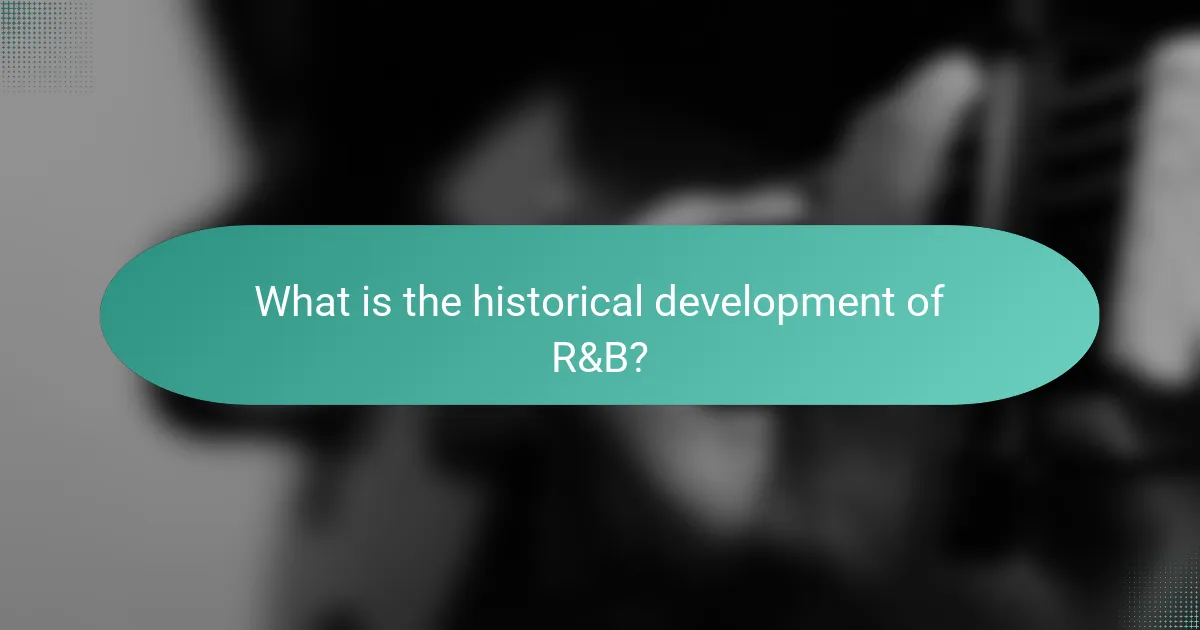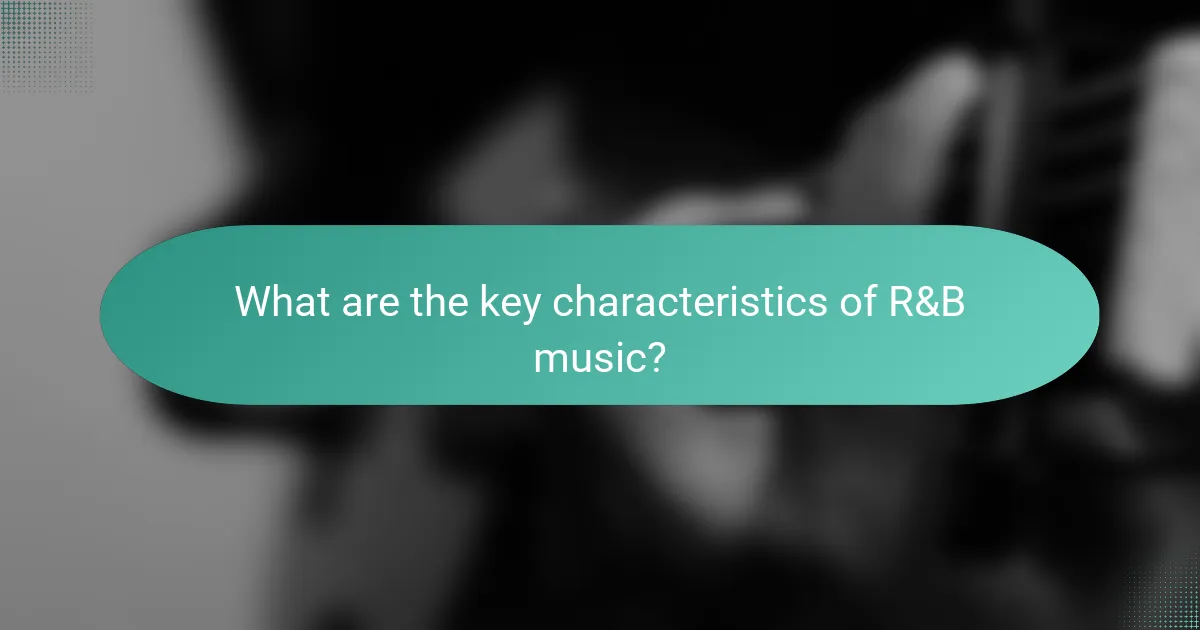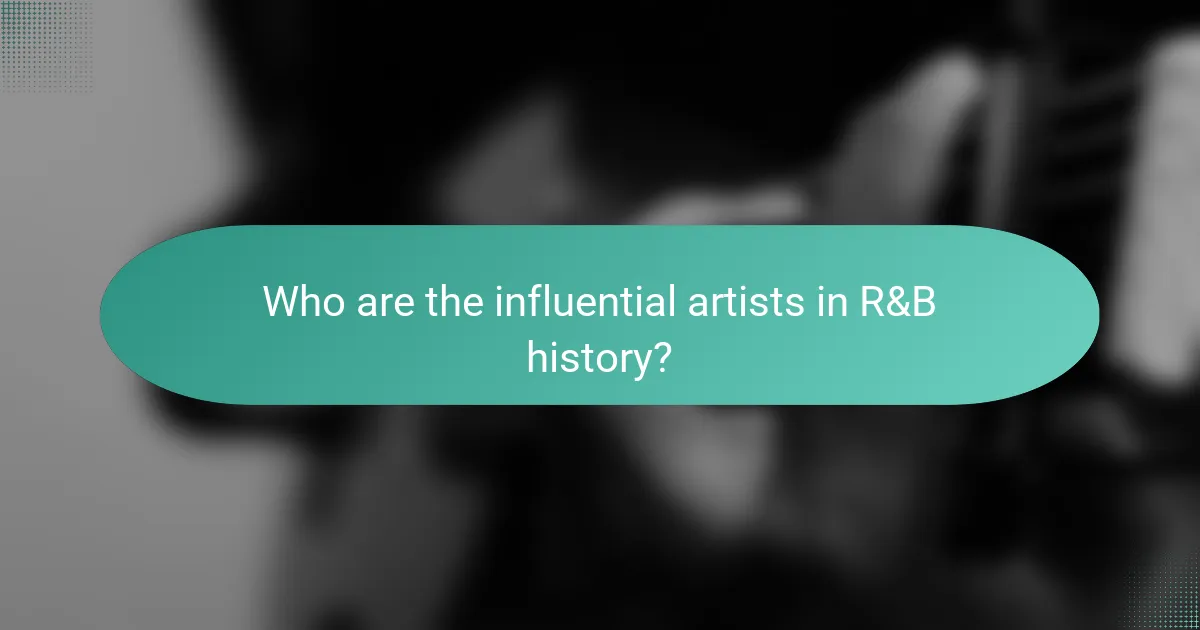R&B, or Rhythm and Blues, is a music genre that originated in the 1940s, combining elements of jazz, gospel, and blues. This article explores the historical development of R&B, highlighting its evolution from “race music” to a mainstream genre influenced by artists such as Ray Charles, Aretha Franklin, and Stevie Wonder. Key characteristics of R&B include strong rhythms, soulful melodies, and emotive vocal performances, often addressing themes of love and personal struggles. The genre has diversified over the decades, giving rise to subgenres like contemporary R&B and neo-soul, while continually integrating new musical styles. Significant contributions from influential artists have shaped R&B’s identity and popularity throughout its history.

What is the historical development of R&B?
R&B, or Rhythm and Blues, originated in the 1940s as a blend of jazz, gospel, and blues. It was initially termed “race music” before being renamed to reflect its African American roots. In the 1950s, R&B gained popularity with artists like Ray Charles and Ruth Brown, who infused elements of rock and roll. The genre further evolved in the 1960s with the Motown sound, characterized by polished production and crossover hits. Artists like Marvin Gaye and The Supremes exemplified this era. By the 1970s, R&B diversified into funk and soul, with influential figures like Stevie Wonder and Aretha Franklin. The 1980s and 1990s saw the emergence of contemporary R&B, blending hip-hop and pop influences, with artists like Whitney Houston and Boyz II Men leading the way. Today, R&B continues to evolve, incorporating various musical styles while maintaining its core elements of emotion and rhythm.
How did R&B evolve from its origins?
R&B evolved from its origins in the 1940s as a blend of jazz, blues, and gospel music. Initially, it was characterized by its rhythmic style and focus on the emotional expression of the African American experience. The genre gained popularity through artists like Ray Charles and Ruth Brown, who incorporated elements of swing and boogie-woogie.
In the 1950s and 1960s, R&B further transformed with the advent of rock and roll, leading to a more upbeat sound. This period saw the rise of Motown, which produced hits with a polished production style. Artists such as Marvin Gaye and The Supremes exemplified this new wave, blending catchy melodies with soulful lyrics.
By the 1970s, R&B diversified into subgenres like funk and disco. This era was marked by artists like Stevie Wonder and Earth, Wind & Fire, who combined complex arrangements and grooves. In the 1980s and 1990s, R&B began to incorporate hip-hop influences, resulting in a new sound characterized by rhythmic beats and vocal harmonies.
Contemporary R&B artists like Usher and Beyoncé have continued this evolution, merging traditional elements with modern production techniques. The genre now encompasses a wide range of styles and remains a significant influence in popular music today.
What were the key influences on early R&B music?
The key influences on early R&B music include gospel, blues, and jazz. Gospel music contributed emotional expression and vocal techniques. Blues provided a foundation of rhythm and storytelling. Jazz introduced complex harmonies and improvisation elements. Additionally, the migration of African Americans to urban areas shaped the genre’s sound and accessibility. Artists like Ray Charles blended these influences, creating a new musical style. The combination of these genres led to the development of rhythm and blues in the 1940s. Early R&B became a bridge to rock and roll, influencing future music styles.
How did social and cultural factors shape R&B in its formative years?
Social and cultural factors significantly shaped R&B in its formative years. The genre emerged in the 1940s, influenced by African American communities. Social changes, such as the Great Migration, brought Black populations to urban centers. This migration created new cultural dynamics and musical fusions. R&B incorporated elements of jazz, blues, and gospel. The civil rights movement also played a crucial role. Artists used R&B to express social struggles and aspirations. The music resonated with audiences, reflecting their experiences and emotions. This cultural context helped R&B evolve into a powerful voice for change.
What are the major milestones in R&B history?
The major milestones in R&B history include the genre’s origins in the 1940s. Rhythm and blues emerged from jazz, blues, and gospel music. In 1949, the term “rhythm and blues” was coined by Jerry Wexler at Billboard magazine. The 1950s saw artists like Ray Charles and Ruth Brown gaining popularity. Motown Records was founded in 1959, leading to widespread success for artists like Marvin Gaye and The Supremes. The 1970s introduced funk influences with artists like Stevie Wonder and Earth, Wind & Fire. The 1980s and 1990s brought the rise of new jack swing, popularized by Teddy Riley. Contemporary R&B evolved in the 2000s with artists like Beyoncé and Usher, blending hip-hop and pop elements. These milestones reflect the genre’s evolution and cultural impact over decades.
Which artists and events marked significant turning points in R&B?
Artists like Ray Charles and Aretha Franklin marked significant turning points in R&B. Ray Charles blended gospel, blues, and jazz, creating soul music in the 1950s. His 1955 hit “I Got a Woman” is often cited as a foundational moment. Aretha Franklin, known as the “Queen of Soul,” brought a powerful vocal style to R&B in the 1960s. Her song “Respect,” released in 1967, became an anthem for both the civil rights and feminist movements. Events like the Motown sound in the 1960s, spearheaded by artists like Marvin Gaye and The Supremes, also transformed R&B. The rise of hip-hop in the 1980s and 1990s further evolved R&B, with artists like Mary J. Blige integrating rap elements. These artists and events collectively reshaped the genre’s landscape and cultural significance.
How did the genre adapt to changes in society and technology?
R&B music adapted to changes in society and technology by evolving its sound and production techniques. The genre incorporated elements from funk, hip-hop, and electronic music as societal tastes shifted. Technological advancements like digital recording and synthesizers influenced the production quality and complexity of R&B tracks. The rise of the internet and streaming platforms changed how artists distribute and promote their music. Artists began to leverage social media for direct engagement with fans, enhancing their reach. Additionally, R&B’s themes evolved to reflect contemporary social issues, such as love, empowerment, and identity. This responsiveness to societal changes ensured R&B remained relevant across generations.

What are the key characteristics of R&B music?
R&B music is characterized by its strong rhythm, soulful melodies, and emotive vocal performances. The genre often blends elements of jazz, blues, and gospel. R&B typically features a prominent backbeat and syncopated basslines. Lyrically, R&B songs often explore themes of love, relationships, and personal struggles. The instrumentation frequently includes keyboards, horns, and guitar, creating a rich sound. Over the decades, R&B has evolved, incorporating hip-hop and electronic influences. Notable subgenres include contemporary R&B and neo-soul. Artists like Ray Charles and Aretha Franklin have significantly shaped the genre’s identity.
What musical elements define R&B?
R&B is characterized by its use of rhythm, blues, and soulful melodies. The genre often incorporates smooth vocals and emotional expression. Instrumentation typically includes bass, drums, and keyboard elements. Harmonic structures often feature seventh chords and complex chord progressions. Syncopation is a common rhythmic element in R&B music. The genre also emphasizes groove and danceability. Lyrical themes frequently revolve around love, relationships, and personal experiences. Influential artists like Ray Charles and Aretha Franklin helped shape these musical elements.
How do rhythm and blues influence the sound of R&B?
Rhythm and blues (R&B) significantly influence the sound of contemporary R&B. This influence is evident in the use of soulful melodies and emotive vocal delivery. Rhythm and blues introduced a strong backbeat, which is foundational in modern R&B tracks. The genre also emphasized the importance of instrumental arrangement, particularly horns and rhythm sections.
Additionally, rhythm and blues laid the groundwork for lyrical themes centered around love and heartache. Many R&B artists draw inspiration from classic rhythm and blues songs, incorporating similar storytelling techniques. The blending of gospel elements with bluesy instrumentation is a hallmark of both genres.
Historically, artists like Ray Charles and Aretha Franklin exemplified this fusion, shaping the sound of R&B. Their work has had a lasting impact on subsequent generations of R&B musicians.
What role do vocals and instrumentation play in R&B music?
Vocals and instrumentation are central to R&B music. Vocals convey emotion and storytelling, often characterized by soulful delivery. Instrumentation provides the rhythmic and melodic foundation. Common instruments include guitar, bass, drums, and keyboards. This blend creates a rich soundscape. The vocal style often incorporates techniques like melisma and improvisation. Instrumentation varies from smooth jazz influences to funk elements. Together, they shape the genre’s identity and appeal.
How do lyrical themes in R&B contribute to its identity?
Lyrical themes in R&B significantly shape its identity by exploring love, heartbreak, and personal struggles. These themes resonate deeply with listeners, creating emotional connections. R&B lyrics often reflect real-life experiences, making the genre relatable. The storytelling aspect is crucial, as it conveys authenticity and vulnerability. For instance, artists like Marvin Gaye and Whitney Houston have used personal narratives to express complex emotions. This approach has established R&B as a genre that prioritizes emotional depth. Furthermore, contemporary artists like H.E.R. and Khalid continue this tradition, addressing issues like mental health and social justice. This evolution demonstrates how lyrical themes in R&B adapt while remaining central to its identity.
What common subjects are found in R&B lyrics?
Common subjects found in R&B lyrics include love, relationships, and heartbreak. These themes often explore emotional connections and the complexities of romance. R&B lyrics frequently address personal struggles and self-identity. Many songs reflect on social issues, such as inequality and empowerment. Additionally, themes of celebration and joy are prevalent in R&B music. The genre often incorporates storytelling elements, sharing personal experiences and anecdotes. Overall, R&B lyrics encapsulate a wide range of human emotions and experiences.
How do emotional expressions in R&B resonate with listeners?
Emotional expressions in R&B resonate with listeners by creating a deep connection through relatable themes. R&B music often explores love, heartbreak, and personal struggles. These themes evoke strong feelings in listeners, allowing them to identify with the artists’ experiences. The use of soulful melodies and expressive vocal techniques enhances the emotional impact. Studies show that emotional music can trigger physiological responses, such as increased heart rate or tears. This connection is supported by the genre’s historical roots in African American experiences and cultural narratives. Artists like Marvin Gaye and Whitney Houston exemplify this emotional resonance through their powerful performances. Their music continues to influence new generations, demonstrating the lasting impact of emotional expression in R&B.

Who are the influential artists in R&B history?
Influential artists in R&B history include Ray Charles, Aretha Franklin, and Stevie Wonder. Ray Charles is known for blending gospel, blues, and jazz, shaping the genre’s foundation. Aretha Franklin’s powerful voice and emotive delivery earned her the title of “Queen of Soul.” Stevie Wonder revolutionized R&B with his innovative use of synthesizers and socially conscious lyrics. Other notable figures include Marvin Gaye, whose album “What’s Going On” addressed social issues, and Whitney Houston, recognized for her vocal prowess and commercial success. These artists significantly impacted R&B’s evolution and popularity.
Which artists have shaped the sound of R&B?
Artists who have shaped the sound of R&B include Ray Charles, Aretha Franklin, and Marvin Gaye. Ray Charles is known for blending gospel, blues, and jazz, which laid the groundwork for modern R&B. Aretha Franklin’s powerful vocals and emotive delivery redefined the genre in the 1960s. Marvin Gaye’s innovative production and socially conscious lyrics elevated R&B’s cultural significance. Other notable artists include Stevie Wonder, whose use of synthesizers transformed the sound in the 1970s, and Whitney Houston, who brought R&B to a global audience in the 1980s. Each of these artists contributed unique elements that continue to influence R&B today.
What contributions did legendary artists make to the genre?
Legendary artists made significant contributions to the R&B genre. They shaped its sound and style through innovation and creativity. Artists like Ray Charles blended gospel and blues, establishing a foundational sound. Aretha Franklin brought emotional depth and vocal power, influencing countless singers. Marvin Gaye introduced socially conscious themes, expanding R&B’s lyrical scope. Stevie Wonder’s experimentation with synthesizers pushed musical boundaries within the genre. These contributions helped R&B evolve, gaining mainstream popularity and cultural relevance. Each artist left a unique imprint, ensuring the genre’s lasting impact on music history.
How did contemporary artists redefine R&B in recent years?
Contemporary artists have redefined R&B by blending it with various genres. They incorporate elements of hip-hop, electronic, and pop. Artists like Frank Ocean and SZA have introduced introspective lyrics and experimental sounds. This shift emphasizes personal storytelling and emotional depth. Additionally, collaborations with producers from different genres have expanded R&B’s sound palette. Streaming platforms have also allowed for greater genre fluidity. This access enables artists to reach wider audiences and experiment freely. The result is a more diverse and innovative R&B landscape.
What impact have these artists had on music and culture?
These artists have significantly shaped music and culture by introducing innovative sounds and themes. They have blended genres, creating unique styles that resonate with diverse audiences. Their lyrics often address social issues, influencing public discourse and awareness. For instance, artists like Marvin Gaye tackled topics like love and social justice, impacting listeners profoundly. The emergence of R&B has also led to the rise of hip-hop and pop, showcasing its versatility. Additionally, these artists have paved the way for future generations, inspiring countless musicians. Their contributions have been recognized through numerous awards and honors, solidifying their legacy in music history. Overall, their influence extends beyond music, affecting fashion, dance, and cultural movements.
How have R&B artists influenced other genres and artists?
R&B artists have significantly influenced various genres and artists by introducing innovative sounds and styles. Their incorporation of soulful melodies and rhythms has shaped pop, hip-hop, and rock music. For instance, artists like Ray Charles and Aretha Franklin blended gospel elements with R&B, impacting the development of soul music. Contemporary artists such as Beyoncé and Usher have integrated R&B influences into pop and hip-hop, expanding their reach. Additionally, R&B’s emphasis on vocal performance has inspired countless singers across genres. The genre’s storytelling and emotional depth have also resonated with songwriters and musicians globally. Overall, R&B’s evolution continues to affect music trends and artist collaborations today.
What legacy do influential R&B artists leave for future generations?
Influential R&B artists leave a profound legacy characterized by musical innovation and cultural impact. They shape genres by blending rhythms, melodies, and vocal styles. Artists like Aretha Franklin and Marvin Gaye pioneered emotional expression in music. Their work addresses social issues, influencing future generations to engage with themes of love, struggle, and identity.
R&B artists also set trends in fashion and performance, inspiring artists across genres. The genre has evolved through their contributions, incorporating elements from hip-hop and pop. This evolution ensures R&B remains relevant and influential. The legacy of these artists is evident in the continued popularity of R&B music today. Their influence can be seen in contemporary artists like Beyoncé and Bruno Mars, who draw from the rich history established by their predecessors.
What are some tips for exploring R&B music today?
To explore R&B music today, start by listening to contemporary artists like H.E.R., Khalid, and SZA. These artists represent modern R&B’s evolution and innovation. Next, utilize streaming platforms like Spotify and Apple Music to discover curated R&B playlists. These playlists often feature both popular and emerging artists. Attend live performances or virtual concerts to experience the genre’s energy and community. Engaging with R&B music forums and social media groups can provide insights and recommendations. Finally, consider exploring the historical roots of R&B by listening to classic artists like Aretha Franklin and Marvin Gaye. Understanding the genre’s origins enhances appreciation for its current forms.
How can listeners discover new R&B artists and tracks?
Listeners can discover new R&B artists and tracks through various platforms and methods. Streaming services like Spotify and Apple Music offer curated playlists featuring emerging R&B talent. These playlists are updated regularly, showcasing fresh tracks. Social media platforms, particularly Instagram and TikTok, allow artists to promote their music directly to audiences. Users can follow hashtags related to R&B to find new artists. Music blogs and websites often feature reviews and recommendations of new R&B releases. Online radio stations dedicated to R&B also introduce listeners to lesser-known artists. Additionally, attending live music events or festivals can provide exposure to new talent in the genre.
What playlists or resources can enhance the R&B listening experience?
Curated playlists and resources can significantly enhance the R&B listening experience. Spotify offers several R&B playlists, such as “Are & Be,” which features contemporary hits and classic tracks. Apple Music has a playlist called “Soul Essentials,” showcasing influential R&B artists from past to present. YouTube Music provides channels dedicated to R&B, featuring music videos and live performances. Additionally, platforms like Tidal offer high-fidelity streaming of R&B albums, enhancing audio quality. Websites like Genius provide lyrics and background information on R&B songs, enriching understanding. Podcasts focusing on R&B history and artist interviews can also deepen appreciation. These resources collectively create a comprehensive R&B listening experience.
The primary entity of the article is R&B (Rhythm and Blues), a genre that originated in the 1940s as a fusion of jazz, gospel, and blues. The article provides a comprehensive overview of R&B’s historical development, highlighting its evolution through various decades, including key milestones and influential artists such as Ray Charles, Aretha Franklin, and Marvin Gaye. It discusses the genre’s defining characteristics, including its musical elements, lyrical themes, and emotional expressions, as well as the impact of social and cultural factors on its growth. Additionally, the article addresses how contemporary artists continue to redefine R&B, ensuring its relevance in today’s music landscape.